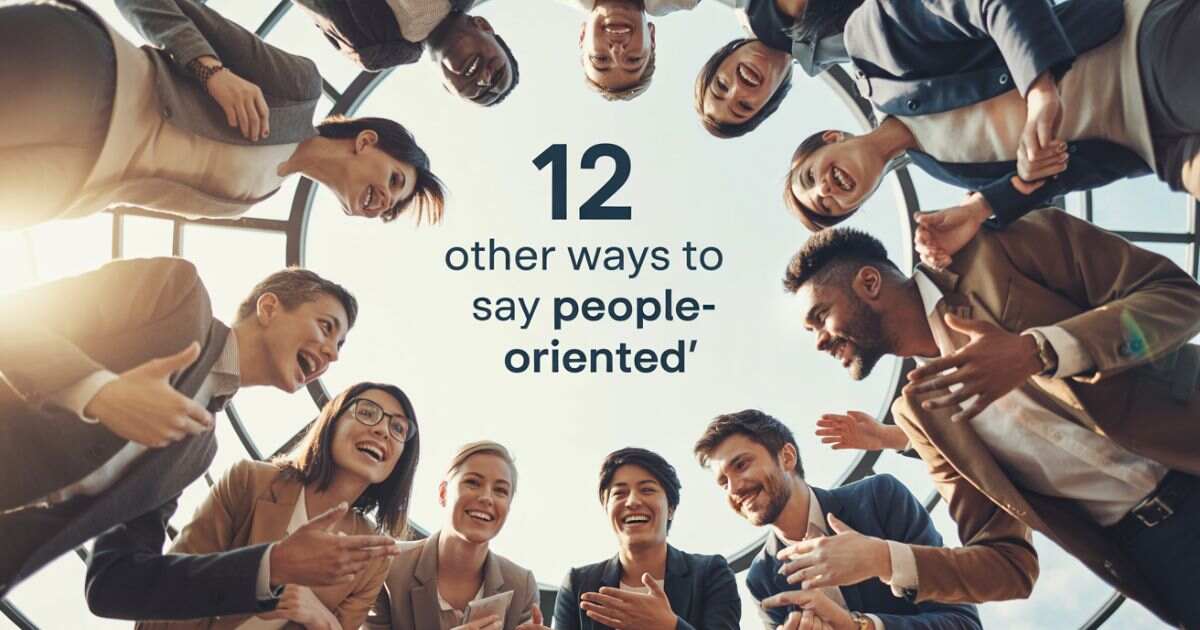Being people-oriented means putting others first, whether in the workplace, in the community, or in daily life. A people-oriented person values connection, kindness, and teamwork. They care about how others feel, think, and respond. In many settings, using the right word for people-oriented behavior makes your message stronger. That’s why knowing other ways to say people-oriented is so useful.
This article shares 12 other ways to say people-oriented, each with a clear meaning and best-use scenario. You’ll learn how to use these words in different settings like work, leadership, education, and more. If you want to sound more natural, caring, and thoughtful, these people-oriented terms can help.
Other Ways to Say “People-Oriented”
Other ways to say people-oriented include terms that highlight empathy, teamwork, and connection. Use them to sound more specific and human.
1. Community-Focused
Example: “She’s community-focused, always putting the neighborhood’s needs at the heart of her projects.”
Meaning: Emphasizes a dedication to community welfare and collective well-being, suggesting actions driven by communal interests.
Usage: Ideal for describing initiatives or individuals involved in local development, uplifting communities, or who demonstrate dedication to community involvement.
2. Team-Centric
Example: “His team-centric leadership style encourages a collaborative and supportive workplace culture.”
Meaning: Highlights the prioritization of team dynamics, working harmony, and achieving goals as a group.
Usage: Best used in settings that value teamwork, office cohesion, and a supportive environment, especially in modern workplaces that rely on cross-functional collaboration.
3. Empathy-Driven
Example: “Her empathy-driven decisions reflect a deep concern for her team’s emotional needs.”
Meaning: Refers to a style where leadership and action are guided by emotional understanding, concern for others, and respect for feelings and perspectives.
Usage: Perfect for describing peers, mentors, or subordinates who respond with care, especially in roles where understanding people is just as important as making decisions.
4. Relationship-Minded
Example: “As a relationship-minded manager, he takes time to personally connect with each employee.”
Meaning: Focuses on building and maintaining interpersonal connections, forming a positive bond, and fostering strong relationships.
Usage: Best for people who invest time in getting to know others, be it in personal or professional settings, and those who are people-focused in their communication.
5. Human-Centric
Example: “The organization’s human-centric policies put employee satisfaction and welfare at the forefront.”
Meaning: Describes strategies, designs, or company policies that place human needs, experiences, and well-being above all else.
Usage: Applies well to design thinking, usability-focused strategies, or organization-wide efforts that are centered on the people they serve.
6. Interpersonally Engaged
Example: “She is interpersonally engaged, always available to listen and offer support to her colleagues.”
Meaning: Refers to someone who actively engages with others on a personal level, showing empathy, presence, and active communication.
Usage: Great for describing individuals deeply involved in the well-being of those around them and who prioritize supportive, real-time participation in conversations and decisions.
7. Compassion-Led
Example: “His compassion-led efforts brought tangible relief to the local community’s health services.”
Meaning: Describes actions or initiatives motivated by a desire to alleviate suffering, show compassion, and provide aid or relief.
Usage: Ideal for people working in community health, nonprofits, or anywhere that motivated, heartfelt service makes a tangible impact.
8. Socially Attuned

Example: “As a socially attuned leader, she adapts her communication style to suit different group dynamics.”
Meaning: Reflects a person’s ability to read social cues, adapt to various communication styles, and respond to the needs of diverse social groups.
Usage: Use this for individuals who are emotionally intelligent, highly aware of interpersonal dynamics, and capable of navigating complex social settings with ease.
9. Interactively Focused
Example: “Their interactively focused workshops emphasize real engagement and growth.”
Meaning: Highlights a focus on personal interaction, active participation, and real-time involvement as keys to success.
Usage: Best for describing development programs, educational spaces, or facilitators who design around engagement and two-way communication.
Read More: 12 Other Ways to Say “Touchpoint”
10. Service-Oriented
Example: “Her service-oriented mindset inspires the entire team to prioritize client needs above all else.”
Meaning: Describes a person or approach that’s driven by a desire to serve, putting others’ needs and expectations first.
Usage: Often used in customer service, public relations, and nonprofit organizations where helping others is a core value.
11. People-First
Example: “The company’s people-first approach guarantees employee voices are heard and respected.”
Meaning: Places people’s well-being, needs, and value at the center of policies, operations, and workplace culture.
Usage: Best for organizations, leaders, or systems designed to promote employee satisfaction, inclusion, and long-term loyalty.
12. Warmly Engaging
Example: “His warmly engaging attitude instantly puts clients and coworkers at ease.”
Meaning: Refers to a natural, friendly way of interacting that makes others feel welcome, seen, and appreciated.
Usage: Ideal for describing someone with a warm, approachable presence, especially in customer-facing roles, where positive relationships are key.
When to Use Different “People-Oriented” Expressions

Knowing when to use different “people-oriented” expressions helps you describe values, actions, or leadership styles with more precision. Whether you’re writing about a supportive manager, a compassionate volunteer, or a community-driven initiative, choosing the right term ensures your message highlights the specific ways people connect, care, and contribute meaningfully.
In Community Service and Nonprofit Work:
Community-Focused: Best for initiatives or individuals whose efforts are aimed at uplifting and supporting the broader community.
Compassion-Led: Ideal for projects or leaders motivated by a desire to alleviate suffering and make a tangible difference in people’s lives.
Socially Attuned: Describes individuals or organizations that are deeply involved in the local context and respond actively to collective needs.
In the Workplace and Team Management:
Team-Centric: Suitable for describing a workplace culture or leadership style that prioritizes team dynamics and cohesion.
People-First: For organizational policies or cultures that place a high value on employee welfare and satisfaction.
Interpersonally Engaged: Perfect for leaders or managers who build strong personal bonds with colleagues and foster a supportive environment.
In Education and Personal Development:
Empathy-Driven: Ideal for educators and mentors who prioritize emotional understanding and student well-being.
Relationship-Minded: Best used to describe teaching styles that emphasize connection and trust with students.
Warmly Engaging: Suited for describing individuals who create a welcoming, inclusive learning atmosphere.
In Leadership and Organizational Culture:
People-First: Best for leadership philosophies that prioritize the needs and perspectives of team members over metrics or profit.
Human-Centric: Ideal for cultures that emphasize dignity, respect, and emotional intelligence in decision-making.
Compassion-Led: Appropriate for organizations where leadership styles are rooted in genuine care for others’ well-being.
In Design and Policy Making:
Human-Centric: Ideal for describing user experience strategies or policies built around real human needs and behaviors.
Empathy-Driven: Fits perfectly when policies or products are designed through the lens of emotional and social impact.
People-Focused: Useful in strategies where usability, accessibility, and welfare are at the forefront of design thinking.
In Customer Service and Public Relations:
Service-Oriented: Best for teams or professionals who put customer needs and satisfaction above all.
Warmly Engaging: Perfect for describing an approach that makes customers feel personally valued and understood.
Listening-Focused: Applies to those who build strong client relationships by actively listening and responding with empathy.
In Social and Interactive Settings:
Interactively Focused: Great for people who thrive on personal connection and encourage involvement in social settings.
Socially Attuned: Describes someone who easily picks up on group dynamics and adapts with sensitivity.
Relationship-Minded: Ideal for individuals who prioritize building and maintaining meaningful personal or group bonds.
Conclusion
Knowing different ways to say people-oriented helps you speak clearly. It also shows that you care about others. These words help you describe people, actions, and goals that put others first. In work, school, or daily life, being people-oriented is a must. It builds trust, respect, and better relationships.
You must use these words when you talk about teamwork, care, or helping others. Words like these show that someone listens, supports, and leads with heart. Being people-oriented isn’t just nice, it’s needed. These terms help you explain that better. So next time you want to show kindness or connection, use a people-oriented word. It makes a real difference.

Grammerroot is your trusted source for mastering English grammar and language skills. From simple rules to advanced tips, we help learners build strong foundations through easy-to-understand content. Learn smart, learn right — only at Grammer Root.




